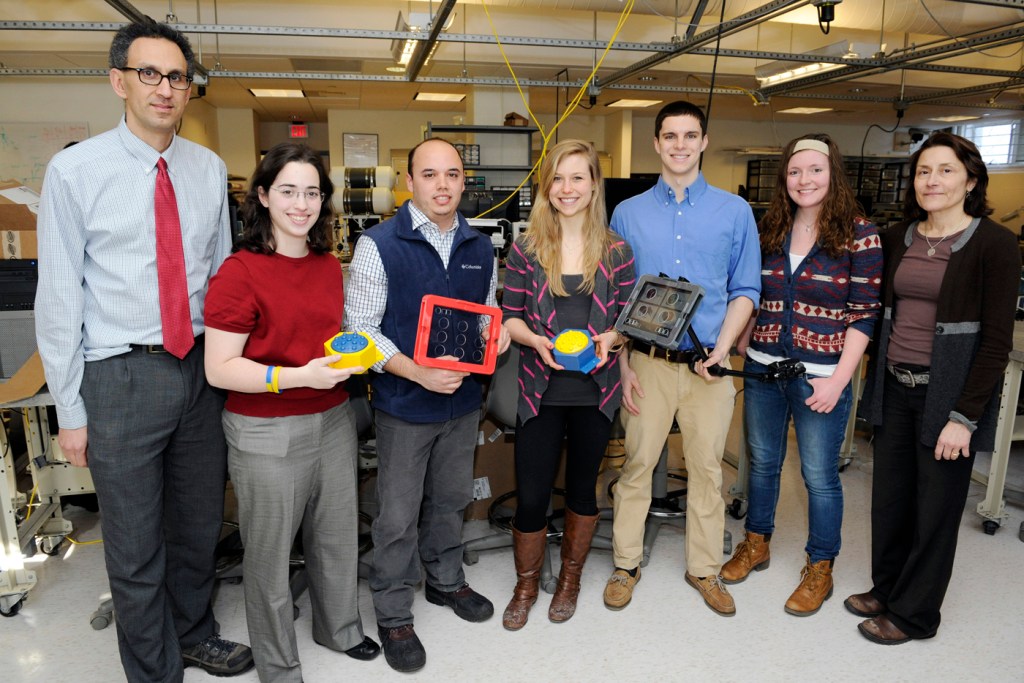Communication devices ‘enable’ children with disabilities

An interdisciplinary group of Northeastern University students and faculty have combined their knowledge of engineering and physical therapy to design, develop, and then deliver two low-cost communication devices to disabled children living at a pair of orphanages in Ecuador.
Undergrads in Northeastern’s Enabling Engineering student group created a so-called communication button and an iPad touchscreen guard, both of which allow kids with cognitive and physical disabilities to more effectively interact with their caretakers. Physical therapy students then delivered the devices to kids living at the For His Children Orphanage, which runs residential care facilities in Quito and Latacunga. The students showed up during spring break, administering therapy to young patients as part of a yearlong capstone course led by physical therapy associate professor Lorna Hayward.
“By linking up the expertise of faculty and students in different colleges, we can inspire our students, help those in need, and build great and relevant projects,” said Waleed Meleis, an associate professor in the Department of Electrical and Computer Engineering who serves as the faculty adviser for the Enabling Engineering student group. “We’re happy to design for individuals because we design for people who aren’t part of the mass market.”
In the past year, he said, more than 50 students, faculty advisers, design mentors, and community partners have worked together to tackle some 20 projects. The touchscreen guard project grew out of a problem-solving meeting between six Northeastern engineering students and instructors at the South Shore Educational Collaborative, a Hingham, Massachusetts-based facility that provides education, counseling, and therapeutic services to approximately 350 people with moderate to intense physical and medical challenges.

Physical therapy students delivered the iPad touchscreen guard and the communication button to kids at the For His Children Orphanage in Ecuador.
The problem, instructors told the students, was that children with developmental delays had trouble pressing the correct buttons on their iPad screens, particularly when using the GoTalk Now app, a communication tool for people who have difficulty speaking. The solution, both parties agreed, was to design a customizable iPad cover that made it easier for children to select the correct items on their educational software.
The engineers-in-training got to work, creating iteration after iteration of the device under the guidance of industry mentor Paul Sabin, the principal of the design firm Fikst. The final prototype, which the students delivered to the residential facility in January, comprised a 3D-printed case and a clear plastic screen guard including four holes to guide users’ button pushing. The screen guard slides onto the case, which holds the iPad.
The device delivered to children in Ecuador included four-hole, six-hole, and nine-hole models, making it easy for any of the kids to correctly use the GoTalk Now app. “They were custom-fit,” said Hayward, who’s been running the alternative spring break trip to the Ecuadorian orphanages for eight consecutive years. “One girl was unbelievable,” she added. “She picked it up so quickly and was making jokes with the app.”
The communication button, she noted, derived from her students’ pre-trip needs assessment of the orphanage’s children. One child—a 4-year-old with autism who is nonverbal and partially blind—was in particular need of an effective way to communicate with his instructors, who found him rather challenging.
The device—which runs on a nine-volt battery and is modeled after the Staples Easy Button—solves that problem, allowing him to effectively communicate with his caretakers. All he must do is press the button, bright blue, bumpy, and mounted to a wall at eye-level, and wait for one of his instructors to heed the pre-recorded command, which issues forth from an implanted recordable sound module and amplifier. “Outside,” it might say, or “I have to use the bathroom.”
Instructors can record a new word or phrase at any time, but the device is presently designed to play back only the most recently recorded utterance. “We wanted to make the button as simplistic as possible, so that it wouldn’t break,” explained Marina Eaves, E’18, one of three students who helped design the device. “The parts are easy to replace and everything is built to last.”
The interdisciplinary collaboration between the engineering students and their physical therapy peers, she said, proved especially useful in the project’s prototyping phase. The button’s bumps, she explained, would never have become part of the device’s design had physical therapy students not brought up the extent to which visually-impaired people rely on touch. “Working across boundaries was really great because it gave us a different perspective on what we were building,” she said. “The physical therapy students knew things about the end-users that we didn’t know.”

A kid at the For His Children Orphanage uses the communication button. Courtesy photo.
Meleis noted that the Enabling Engineering group wants to refine—and ultimately commercialize—both devices. And he and Hayward, he said, are currently working to design a joint course for engineering and physical therapy students alike. “Students are craving interdisciplinary experiences,” he explained, “and they want to feel like what they’re studying is having a true impact on people’s lives.”
The students that contributed to the project, whether in the design or implementation phase, found that the experience had transformed their career ambitions. Samantha Bell, E’18, who helped to design both devices, discovered her passion for product development and then lined up a co-op with Columbia Tech, the Westborough, Massachusetts-based firm. “I like to make things,” she said, “and I love to help people.”
Nick Mangone, BHS’16, helped program the iPads for the orphanage’s children, and then spent the next several days administering physical therapy and watching them enjoy their new communication tools. “I’d definitely be interested in working in the pediatric setting,” he said. “It’s very rewarding to be able to do something that allows someone to be independent and see how happy it makes them.”




